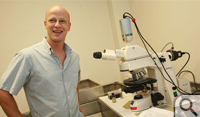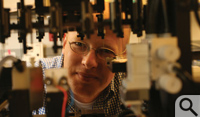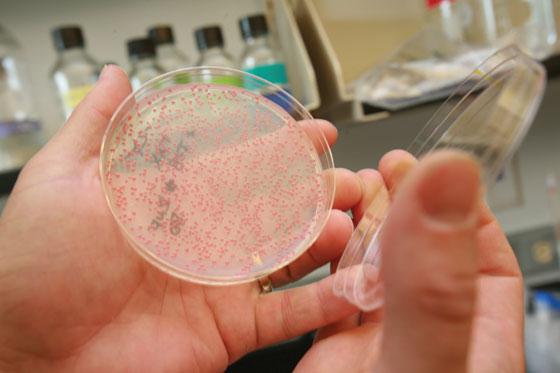Biological research in the ISC: Cure cancer by studying yeast? Yes.
When future generations tell the story of how medical scientists found a cure for cancer or other diseases resulting from DNA damage, the first chapters may center on an unassuming and unlikely character—yeast.
“We work with the same stuff you use to bake bread,” Oliver Kerscher says. “It’s cheap and it gives you good results. I can take you in my lab and teach you everything you need to know to work with it in three weeks.”
Kerscher and his students study the interaction of genes in the chromosome cycle, a complex, elegant process through which cells make copies of themselves. Errors in the process can lead to DNA damage, resulting in health problems that range from cancer to Down’s syndrome to spontaneous abortions. By studying imperfections in the yeast cell-replication cycle, they hope to better understand the roots of DNA damage in humans. Abundant and easily cultivated, yeast has another, more important, quality for basic-science studies, Kerscher said.
A 60-percent solution
“Yeast can tell a lot about this process, because about 60 percent of the genes that exist in yeast cells are homologous to genes in humans—meaning they actually look like the genes that play roles in similar processes in humans,” he explained. “So if I can understand the role of a certain gene involved in the chromosome segregation in yeast, there is a good chance I can tell you the function of that gene in humans.”
Imagine a biological Xerox
Kerscher, an assistant professor of biology at the College of William and Mary, points out that a properly functioning chromosome cycle is important, as the process is no less than the means by which the body’s cells replenish themselves. Imagine a biological Xerox in which the copy, ideally, should be indistinguishable from the original. The content that’s being replicated from what biologists call the mother cell to the daughter cell is DNA.
Kerscher described a multi-step process through which the mother cell duplicates its chromosomes, aligns the two sets and then divides off the daughter cell. The process is characterized by checkpoints at which the cell examines itself.
“It stops the cell cycle and says, OK, let’s see if we have everybody. Our DNA has been healthy? No DNA damage at this point?,” he explained. “Only when the cell has checked that there is no DNA damage, then it will go on with the next step.”
If the cell does detect something is amiss, it will send out an enzyme repair squad to repair the damage. Kerscher said that the checkpoints and repair systems make for very robust quality control—but nothing is perfect. Even with a mistake occurring only at a rate of one in every hundred thousand cell divisions, a body containing somewhere around 50 trillion cells is vulnerable.
How cancer can begin
“Trouble can arise if you make one serious mistake on the wrong gene. You can imagine that on a sunny day, you go out and accumulate a lot of UV damage in your skin’s DNA. If you have one of your DNA repair proteins missing, you are unable to repair the DNA. The unrepaired DNA leads to a problem in the chromosome cycle, the next division cycle. The damage can start to accumulate,” Kerscher said. “Cancer is actually a multi-step process.”
The steps of the chromosome cycle are regulated by a crew of molecules, proteins, enzymes and genes which each have a function in the elegant process. Kerscher’s lab focuses on the role of individual genes in the chromosome cycle in yeast.
“We have at least one or two cases in the lab of genes that we first have identified in yeast and that now appear to play a very important role in humans,” he said. “The role of these genes was not identified because we studied humans or human cell life—but the role of the genes was identified because we understood the function in yeast first.”
For instance, his lab has been focusing on the function of a yeast gene known as HEX3, usually found bound to its “buddy protein” SLX8. Kerscher explained that the HEX3/SLX8 complex may act as a biochemical terminator of the enzymes that perform repair of damaged DNA.
“You not only need to make sure that DNA damage-repair comes on, but you also have to make sure that it gets turned off again,” he said, “because these DNA repair enzymes meddle with DNA. You don’t want them unsupervised and hanging out with DNA, because they can take DNA and recombine it, meaning they can re-shuffle the genetic information. So you need to keep them in a locked box and you let them out only if you really, really need them.”
HEX3/SLX8 identifies the repair enzymes after their work is done and, as Kerscher suggests, may send them to the “molecular wastebasket”—the proteasome—by adding a “death tag” of ubiquitin to the molecule. In the context of the whole chromosome cycle, ubiquitin acts as a kind of traffic cop. Kerscher explained that many of the steps in the cycle are halted by a molecular stop sign. “Ubiquitin,” he explained, “says ‘get rid of that stop sign.’”
The lab has discovered that another protein known as SUMO serves as a signal to attract HEX3/SLX8 to its target proteins in a manner that Kerscher says might be “almost like a search and destroy mission” within the cell.
“The search comes in because HEX3/SLX8 looks for SUMOylated target proteins that meddle with DNA damage,” he said. “The proeins already have a little flag on them, a SUMO flag” which may mark them for destruction via HEX3/SLX8 mediated ubiquitination.
Search and reorganize
Kerscher explained that the HEX3/SLX8 complex’s search-and-destroy mission may actually be a search-and-reorganize mission, in which the DNA target proteins are biochemically reorganized into another part of the cell by the ubiquitin, rather than being sent to the molecular wastebasket of the proteasome.
“I think that’s our claim to fame. We were the first guys to show that SUMOlation leads to ubiquitination,” he said. “It doesn’t sound like it affects your life every day—but let me tell you, if you don’t have ubiquitin in your cell, you end up with a whole bunch of trouble, because a lot of proteins that are not supposed to be in your cell start to accumulate. You can have neurodegenerative diseases, as one example, but you can also skew cells within the cell cycle if you don’t have proper ubiquitination, because the synchronization of the cell cycle is actually mediated by ubiquitin.”
The study of yeast is valuable because the workings of the yeast chromosome cycle are quite similar to the same cycle in mammals—including humans. They’re similar, but not identical, because some of the functions performed in our never-ending cell cycle are performed by different molecules than those in yeast. For instance, the function performed by HEX3/SLX8 complex in yeast is handled by a single, unaccompanied gene known as RNF4.
The relationship between our own RNF4 and HEX3/SLX8 in yeast is surprisingly close. Laura Boutwell ’09, an undergraduate researcher in Kerscher’s lab, was able to knock out the HEX3/SLX8 from some yeast samples and replace it with the human RNF4 gene. Kerscher said the cell cycle continued just as expected, only with the human gene in the driver’s seat.
“So we can take a human gene, put it into the yeast cell and it shows a function. Now if you have a better way to show the function of the human gene, I don’t know what it could be,” Kerscher said. “So we can do genetics, we can do cell biology, we can do biochemistry and we can also do molecular biology with yeast. It’s extremely powerful and you don’t have to do research on humans and we don’t have to kill any animals…and it’s easy to learn.” 
















